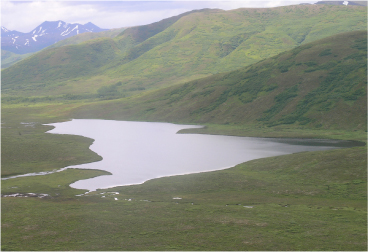|
J of Paleolimnology special issue Synthesis and data-model comparison
New: ARCSS 8k project |
A 2000 year record of climatic change at Ongoke Lake, southwest AlaskaChipman, M.L., Clarke, G.H., Clegg, B.F., Gregory-Eaves, I., and Hu., F.S. AbstractStudy LocationOngoke Lake is situated southeast of the Ahklun Mountains approximately 50 km northwest of Dillingham, Alaska. It lies within the Bristol Bay Lowlands, with climate moderated by the Bering Sea and North Pacific Ocean. Mean annual rainfall in Dillingham is 67 cm yr-1, with approximately 40% occurring between July and September. Mean annual temperature is 1.2°C (January mean = –8.8°C, July mean = 13.1 °C). Annual snowfall amounts to 228 cm on average. Modern vegetation surrounding the lake is shrub tundra dominated by birch (Betula nana and Betula glandulosa). Maximum lake-water depth is 7 m. Climate ProxyWe used biogenic silica (BSi), diatom assemblages, carbon to nitrogen ratios, LOI, and chironomids to characterize the last 2000 years of climate at Ongoke Lake. Principal components analysis (PCA) was used to summarize the diatom-assemblage variation and infer climatic and limnological changes through time. A regional diatom transfer function was also applied to the diatom assemblages to reconstruct lake-water depth in order to infer changes in effective moisture. ResultsVariation in diatom ecology (summarized on PCA axis 1) and chironomid data from Ongoke Lake suggests changes in the strength of thermal stratification and duration of ice cover that may be related to temperature variation. This data suggest a cold interval ~400 AD, a warm interval ~950 to 1700 AD, and cooling ~1740 AD persisting till present. Effective-moisture variation, as interpreted from the water-depth reconstruction and diatom PCA axis 2, coincides with periods of distinct temperature anomalies documented at other Alaskan sites. Comparing the Ongoke Lake reconstruction to other climatic records illustrates spatial variability in the moisture regime within Alaska. References
|
